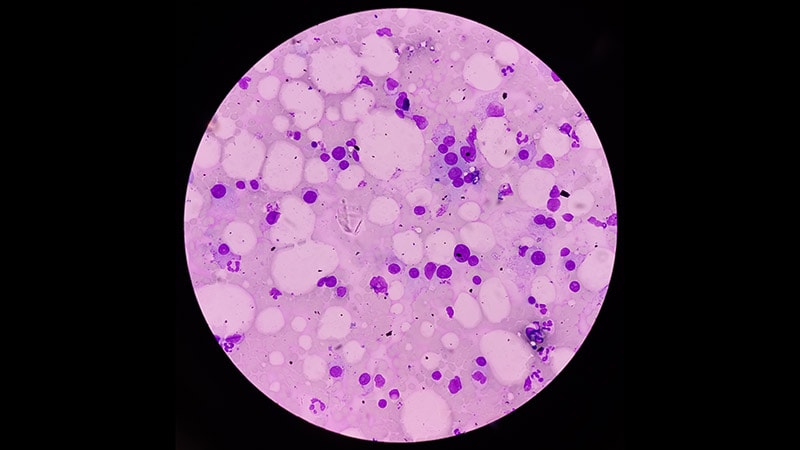TOPLINE:
Belantamab mafodotin plus a combination of bortezomib and dexamethasone improved median progression-free survival (PFS) by 23 months in patients with relapsed or refractory multiple myeloma compared with daratumumab alongside the same combination.
METHODOLOGY:
- Patients with multiple myeloma who relapse often become refractory to frontline triplet or quadruplet regimens and need effective second-line options.
- The researchers evaluated triplet therapy with belantamab mafodotin — a first-in-class anti–B-cell maturation antigen monoclonal antibody conjugate — vs daratumumab as a second-line or later treatment option in patients with relapsed or refractory multiple myeloma.
- In this multicenter, open-label, randomized, phase 3 trial, 494 patients with relapsed/refractory multiple myeloma who previously received at least one prior line of therapy received bortezomib plus dexamethasone with either belantamab mafodotin or daratumumab.
- The primary outcome was PFS; secondary endpoints were overall survival, duration of response, and overall response rate.
TAKEAWAY:
- At a median follow-up of 28.2 months, patients who received belantamab mafodotin demonstrated significantly longer median PFS than those who received daratumumab (36.6 vs 13.4 months; hazard ratio [HR], 0.41). The improvement was evident in all prespecified groups, including patients refractory to lenalidomide (HR, 0.37) and those with a high risk for cytogenetic abnormalities (HR, 0.36).
- The early overall survival trend favored belantamab mafodotin — with 84% of patients alive at 18 months vs 73% in the daratumumab group — but overall survival follow-up is ongoing.
- The overall response rate was 83% in the belantamab mafodotin group vs 71% in the daratumumab group. Complete response rates were also higher in the belantamab mafodotin: 34.6% vs 17.1%. Median duration of response was twice as long in the belantamab mafodotin group (36 vs 18 months).
- Grade 3 or higher non-ocular adverse events in belantamab mafodotin vs daratumumab group included thrombocytopenia (55% vs 35%), infections and infestations (31% vs 20%), neutropenia (12% vs 6%), pneumonia (12% vs 4%), and anemia (8% vs 10%). Grade 3 or higher ocular adverse events were reported in 34% of patients treated with belantamab mafodotin, but ocular toxicities reversed in most patients.
IN PRACTICE:
Based on favorable PFS and manageable safety profile, belantamab mafodotin in combination with bortezomib plus dexamethasone has potential to become a new standard of care in the second line or later among patients with relapsed or refractory multiple myeloma, the author concluded.
SOURCE:
This study, led by Maria-Victoria Mateos, MD, PhD, from University Hospital of Salamanca, Salamanca, Spain, was presented at ASCO Plenary Series: February 2024 Session and published in the Journal of Clinical Oncology.
LIMITATIONS:
Open-label design was a limitation of this study. Follow-up for overall survival was ongoing.
DISCLOSURES:
This study was funded by GSK. Mateos reported receiving honoraria, consulting/personal fees outside this work.
Source link : https://www.medscape.com/viewarticle/belantamab-mafodotin-tops-daratumumab-multiple-myeloma-2024a10002vl?src=rss
Author :
Publish date : 2024-02-09 05:02:48
Copyright for syndicated content belongs to the linked Source.
